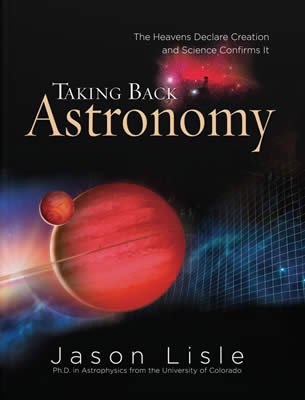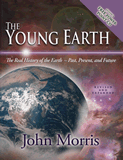
Chapter 3
The Age of the Universe, Part 2
[Web editor’s note: The first part of this chapter discusses the big bang’s underlying assumptions, distant starlight, and creation compromises and introduces the evidences for a young universe. Part 2 continues listing these evidences. For a more technical treatment, see the in-depth box below.]
Recession of the Moon
As the moon orbits the earth, its gravity pulls on the earth’s oceans, causing tides. Since the earth rotates faster than the moon orbits, the tidal bulges induced by the moon are always “ahead” of the moon. For this reason the tides actually “pull forward” on the moon, which causes the moon to gain energy and gradually spiral outward. The moon moves about an inch and a half farther away from the earth every year due to this tidal interaction. Thus, the moon would have been closer to the earth in the past.
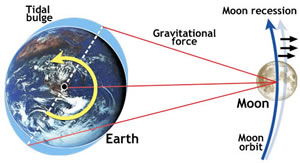
Six thousand years ago, the moon would have been about 800 feet (250 m) closer to the earth (which is not much of a change considering the moon is nearly a quarter of a million miles, or 400,000 km, away). So this “spiraling away” of the moon is not a problem over the biblical time scale of 6,000 years, but if the earth and moon were over 4,000,000,000 years old (as big-bang supporters teach), then we would have big problems. This is because the moon would have been so close that it would actually have been touching the earth less than 1.5 billion years ago. This suggests that the moon can’t possibly be as old as secular astronomers claim.
Secular astronomers who assume the big bang is true must invoke other explanations to get around this. For example, they might assume that the rate at which the moon was receding was actually smaller in the past (for whatever reason), but this is an extra assumption needed to make their billions-of-years model work.
The simplest explanation is that the moon hasn’t been around for that long. The recession of the moon is a problem for a belief in billions of years, but is perfectly consistent with a young age.
The Magnetic Field of the Earth
Most people have some familiarity with magnets, like the kind that stick to a refrigerator door. Magnets have an almost “magical” ability to attract other magnets or certain metals separated by a distance—they seem to reach out over space and pull with invisible fingers. The region of space surrounding a magnet which exerts a force on other magnets is called a “magnetic field.” Magnetic fields are caused by electric current—motion of charged particles.4
The earth’s magnetic field is approximated by a “dipole”—meaning the magnet has one north pole and one south pole. This dipole is roughly aligned with the earth’s rotation axis (being off by about 11.5 degrees). That is, the north magnetic pole is close to the north rotation pole. This is why a compass points approximately north; it aligns with the geomagnetic field. This magnetic field surrounds the earth and is an important design feature. The universe contains radiation which is harmful to living tissue. Earth’s magnetic field protects life by deflecting dangerous cosmic radiation. The atmosphere also offers some protection.
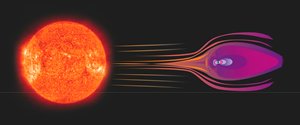
The earth’s magnetic field
The earth’s magnetic field is caused by electric currents within its interior. Such currents encounter electrical resistance, and so they naturally decay with time. We would therefore expect that earth’s magnetic field would become weaker as time progresses. We have been able to measure the strength of the magnetic field for over a century, and not surprisingly, the earth’s magnetic field is indeed decaying. Every century, the magnetic field decays by about 5 percent. Since the earth’s magnetic field gets weaker as time moves forward, it must have been considerably stronger in the past. Approximately 6,000 years ago, the magnetic field would have been quite a lot stronger, but still perfectly suitable for life.
However, if the earth were many millions of years old, then the geomagnetic field would have been so strong in that alleged distant past, that life would not have been possible.5
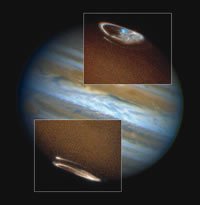 |
Jupiter’s aurora |
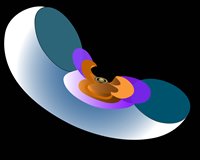 |
Saturn’s magnetic field |
Magnetic Fields of the Planets
Many of the planets of the solar system also have strong dipole magnetic fields. Jupiter’s magnetic field, for example, is extremely powerful. The magnetic fields of Uranus and Neptune are also quite strong. If these planets were really billions of years old (as secular astronomers believe), their magnetic fields should be extremely weak by now. Yet, they are not. A reasonable explanation for this is that these planets are only a few thousand years old, as the Bible teaches.
The suggestion that the solar system is only thousands of years old is, of course, an intolerable position for those who believe in particles-to-people evolution. The vast ages are required for their worldview, and so must be protected at all costs. Therefore, the apparent youth of the universe must be explained away by the addition of auxiliary hypotheses. For example, secular astronomers have proposed that planetary magnetic fields can be “recharged” over time. Specifically, they invoke the idea of a “magnetic dynamo” powering the magnetic fields of planets. The basic idea is that motion within the planets can regenerate the magnetic fields so that the total field strength will not decay. However, the planets do not fit the conditions necessary to drive such a dynamo. The simplest explanation is that the solar system is much younger than billions of years.
Magnetic Fields Confirm Recent Creation
Dr. Russ Humphreys, (a Ph.D. physicist and biblical creationist) has produced a model of planetary magnetic fields which can explain their present strengths in terms of biblical creation.10 In essence, the model estimates the initial strength of each magnetic field at the moment of its creation, then the model computes their present strengths based on 6,000 years of decay from electrical resistance. Impressively, this biblically based model is able to account for the present measured magnetic fields of all the known planets11 and even many of the moons as well.
Of course, almost any model can be “adjusted” to fit existing data, so it is perhaps even more impressive that Dr. Humphreys’ model successfully predicted the present magnetic field strengths of the planets Uranus and Neptune before they were measured by the Voyager spacecraft. Specific, successful predictions are the mark of a good scientific model. Dr. Humphreys also predicted that Mars would have remanent (permanent) magnetism, which has now been confirmed.12 Remanent magnetism occurs in rocks which cooled and solidified in the presence of an external magnetic field. Such remanent magnetism is also found on the moon. This confirms that both the moon and Mars once had strong magnetic fields as expected in the Humphreys model. Planetary magnetic fields strongly support the biblical age of the solar system.
Spiral Galaxies
A galaxy is an enormous assembly of stars and interstellar gas and dust. Galaxies occur in a range of sizes and can contain anywhere from a million to a trillion stars. Our galaxy (the Milky Way) contains over 100 billion stars. Galaxies also come in a range of shapes. Many are round or elliptical in nature. Others have an irregular shape, such as the clouds of Magellan—two satellite galaxies of the Milky Way. Some of the most beautiful galaxies are spiral in nature. A spiral galaxy has a flat-disk shape with a central bulge. The disk section contains spiral arms—regions with greater numbers of stars which extend from the periphery of the galaxy to the core.

Differential rotation of a spiral galaxy
Spiral galaxies slowly rotate, but the inner regions of the spiral rotate faster than the outer regions; this is called “differential rotation.”13 This means that a spiral galaxy is constantly becoming more and more twisted up as the spiral becomes tighter. After a few hundred million years, the galaxy would be wound so tightly that the spiral structure would no longer be recognizable. According to the big-bang scenario, galaxies are supposed to be many billions of years old, yet we do see spiral galaxies—and lots of them. This suggests that they are not nearly as old as the big bang requires. Spiral galaxies are consistent with the biblical age of the universe, but are problematic for a belief in billions of years.
Secular astronomers have proposed “spiral density waves” to create new spiral arms as old ones become twisted beyond recognition. The idea is that waves of pressure travel around the galaxy and stimulate new star growth. Of course, such waves have not been observed, so the idea remains a conjecture. Furthermore, the spiral density wave notion assumes that stars can form spontaneously. Although virtually all secular astronomers assume this, star formation has significant problems of its own. Furthermore, there are difficulties in starting any supposed density wave in the first place. Such complications are not necessary if we accept the most straightforward interpretation of the evidence: galaxies are not billions of years old.
Comets
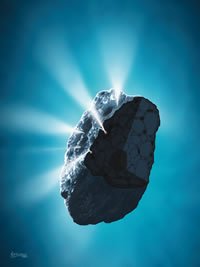
Interior view of a comet

Hale-Bopp comet
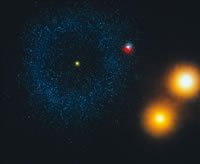
Artist rendition of the (purely hypothetical) Oort cloud as seen from the Alpha Centuri system
Comets are balls of ice and dirt which orbit the sun, often in highly eccentric orbits. The solid central portion of a comet is called the nucleus. Comets generally have a region of vaporized material surrounding them which appears as a faint “fog”—this is called the “coma.” Comets spend most of their time moving slowly near the point in their orbit that is farthest from the sun (aphelion). As they approach the sun, they speed up and slingshot around the sun, moving fastest at the closest point (perihelion). It is during these points of close approach that many comets develop a “tail”—a stream of vaporized material which extends away from the comet. The tail points away from the sun, because the material is swept away by solar wind and radiation. Often two tails develop: an ion tail consisting of light charged particles, and a dust tail containing heavier materials. The ion tail is slightly blue in color; it is straight and points directly away from the sun. The dust tail is white and is generally curved. Sometimes only one of the two tails is visible.
A comet’s tail (or tails) is an indication that comets cannot last forever. The tail means that the comet is losing material; a comet gets smaller every time it orbits the sun. It has been estimated that a typical comet can only orbit the sun for about 100,000 years at most before completely running out of material. (This is an average figure, of course; the exact life span would depend on how big the comet is to begin with, and the parameters of its orbit.) Since we still have a lot of comets, this suggests that the solar system is much younger than 100,000 years.This agrees perfectly with the Bible. Clearly, 4.5 billion years would be an absurdly inflated age for comets.
How do secular astronomers attempt to reconcile this with their belief in billions of years? Since comets can’t last that long, secular astronomers must assume that new comets are introduced to the solar system to replace those that are gone, so they’ve invented the idea of an “Oort cloud.”14 This is supposed to be a vast reservoir of icy masses orbiting far away from the sun. The idea is that occasionally an icy mass falls into the inner solar system to become a “new” comet. It is interesting that there is currently no evidence of an Oort cloud, and there is no reason to believe in one if we accept the creation account in Genesis. Comets are consistent with the fact that the solar system is young.
Conclusions

This NASA Hubble Space Telescope image shows one of the most complex planetary nebulae ever seen, NGC 6543, nicknamed the “Cat’s Eye Nebula.” Hubble reveals surprisingly intricate structures including concentric gas shells, jets of high-speed gas and unusual shock-induced knots of gas.
Clearly, there are many evidences which are fully consistent with the biblical age of the universe and are difficult to reconcile with a belief in billions of years. They are not “proofs,” since big-bang supporters can always invent non-falsifiable conjectures to explain away these evidences, but we have seen that when we use the Bible to understand the age of the universe, the evidence is certainly consistent.
In most of the arguments for a young universe discussed above, we have used uniformitarian and naturalistic assumptions, which of course we do not accept. We have deliberately used the assumptions of the opposing point of view to show that these assumptions lead to contradictions. For example, we showed that assuming that the moon formed naturalistically 4.5 billion years ago, and that the rate of spiraling away hasn’t deviated (from the constant 1/r6 relation) then the moon can’t be older than 1.5 billion years—a contradiction. Such inconsistencies are common in non-biblical worldviews.
Uniformitarianism is a blind philosophical assumption; it is not a conclusion based on evidence. Furthermore, it is incompatible with the Bible. The present is not the key to the past. Just the opposite: the past is the key to the present! The Bible is the revealed Word of the Creator God who knows everything, and has given us an accurate account of history. The Bible (which tells us about the past) is the key to understanding the present world. When we start with the Bible as our presupposition, we find that it makes sense of the world. Of course the planets would have strong magnetic fields; of course galaxies would not be twisted up; and of course we still have comets. These are what we would expect in a biblical worldview. The Bible is true, and the evidence confirms that the universe is thousands of years old.
Creation In-Depth:
Recession of the Moon
Tidal bulges develop on earth because the moon is closer to one side of the earth than the other, and thus its gravity pulls harder on the near side. This causes the overall shape of the earth to be slightly elliptical. The height of the tidal bulges would be greater if the moon were closer to the earth. The earth rotates faster than the moon revolves; thus, the tidal bulges are always ahead of the moon. Since they pull forward on the moon, the bulges transfer angular momentum and kinetic energy—increasing the moon’s orbital energy and causing it to move away from the earth. The rate of this recession is approximately proportional to the inverse sixth power of the earth-moon distance. As a rough estimation, this can be shown as follows:
The tidal bulges are approximated as a dipole (two points separated from the center of the earth). The dipole separation is proportional to 1/r3, where r is the earth-moon separation.1 So, we would expect that tidal bulge height goes as roughly h=1/r3. However, the force with which the tidal bulges pull back on the moon also goes as h/r3 for a given height (h). So we expect the rate of tidal recession goes as approximately 1/r6.
It follows that the equation describing tidal recession is:
dr/dt = k/r6
The constant k can be found using the current measured rate of lunar recession: 3.8 cm/year. Thus, k = r6dr/dt = (384,401km)6 x (.000038km/year) = 1.2 x 1029 km7/year. The lunar recession equation is then solved for the extreme case (the upper limit on age of the moon):
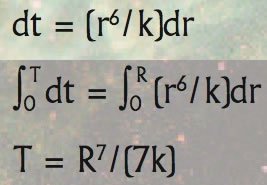
Here, T is the maximum age for the moon since this assumes it migrated from a distance of zero to its current distance of R = 384,401 km. Plugging in the known values gives an upper limit on the age of the earth-moon system of T = 1.5 billion years—much less than the 4.5 billion years that evolutionists require.
Since critics of biblical creation cannot accept this conclusion, they are forced to adopt secondary assumptions to make the evidence fit. Some have suggested that k may not be constant in time; perhaps the different distribution of continents in the past affected the tidal breaking of the earth’s oceans. This speculation does not necessarily solve the problem though. First, a different continental distribution does not guarantee that k would be smaller; if it were larger, then the problem would be even worse.
Second, k would have to be substantially smaller in order to ameliorate the problem. Third, geological evidence argues against this claim, even if we accept the evolutionary/long-age interpretation of such evidence. Studies of tidal rhythmites performed by secular scientists are consistent with k being approximately constant over geologic time (assuming the evolutionists’ dating methods).2 Furthermore, there is no evidence of the extreme tides that would have resulted from a moon that is very close to the earth.3 Of course, this is what biblical creationists would expect, since the moon was only about 800 feet (250 m) closer at creation, roughly 6,000 years ago.
Getting Around the Magnetic Field Evidence
The straightforward interpretation that the earth is not billions of years old is, of course, an intolerable conclusion for evolutionists. Additional assumptions are therefore required to explain this evidence within the naturalist’s worldview. So far, however, the secular explanations have not been able to endure careful scrutiny. For example, some secular scientists have suggested that only the dipole component of earth’s magnetic field has been decaying, and that the non-dipole components have increased in energy to compensate. They’ve suggested that the overall energy of earth’s magnetic field has not decreased. However, this is not the case; any increase in the non-dipole field has been shown to be much smaller than the decrease in the dipole field.6 Thus, the total energy of the earth’s magnetic field is decaying and therefore supports a recent creation.
Magnetic Dynamo Versus Magnetic Decay
Magnetic and electrical energy can be generated from mechanical energy (motion). This is how the alternator in a car works. Undoubtedly, there are places in the universe where mechanical energy is converted into magnetic fields. It seems likely that the sun undergoes just such a process; it reverses its magnetic field every 11 years. Many secular astronomers assume that the planets also undergo such a process (though this has not been observed in the present). However, the fact that such processes can occur (and there is good evidence for magnetic reversals preserved in earth rocks, for which there is a respectable creationist theory7) does not necessarily solve the problem of strong magnetic fields for an “old” universe.
First, an electromagnetic-mechanical system must be set up in just the right way in order to cause the total magnetic field energy to increase. There is no guarantee that vigorous motions which cause magnetic field reversals could actually recharge the total magnetic field energy and prevent it from decaying with time. In fact, such magnetic field reversals might actually accelerate the decay of the total field strength—as may be the case with the sun.8
Second, there are a number of good reasons to believe that the magnetic fields of the planets are not dynamos, and are much different than that of the sun. The sun is so hot that most of its atoms are ionized—the electrons have been stripped away from the nucleus in a state called “plasma.” Plasma is highly sensitive to magnetic fields, and interacts with them much more strongly than neutral gas. The turbulent motions within the sun are constantly generating chaotic bits of magnetism. However, the planets are not made of plasma and do not exhibit the kinds of motions we see in the sun. Additionally, in the process by which the sun is thought to reverse its magnetic field, the rotation axis should be almost exactly aligned with the magnetic poles. This is the case for the sun, but not for the planets. In fact, the planets Uranus and Neptune have magnetic fields which are tilted severely relative to their respective rotation axes.
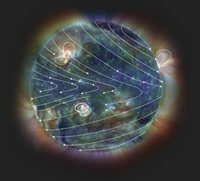
The sun also possesses powerful toroidal magnetic fields (in addition to a dipole field). Instead of having a north and south magnetic pole, toroidal magnetic fields make a complete loop around the sun, forming bands parallel to the solar equator. At least one band exists in the Northern Hemisphere, and another is in the Southern Hemisphere with opposite polarity. Sunspots generally occur at the latitudes of these toroidal bands. These toroidal magnetic fields are critical in the process of reversing the sun’s magnetic field, and yet the planets do not show evidence of strong toroidal magnetic fields. Moreover, there is no evidence that the magnetic fields of the planets are reversing today as the sun’s does.9 The magnetic fields of the planets today are consistent with the simple decay produced by electrical resistance.
Dr. Humphreys’ model of planetary magnetic fields
Dr. Russ Humphreys has produced a creation-based model of planetary magnetic fields. This model proposes that when God created the planets of the solar system, He made them first as water which God then supernaturally changed into the substances of which the planets are comprised today. This idea may be suggested (at least for the earth) in passages such as 2 Peter 3:5. Water molecules can have a small magnetic field of their own due to the quantum spin of the proton in each of the two hydrogen atoms. If a significant fraction of these molecular magnetic fields were aligned when the planets were first created, they would add to produce a strong dipole magnetic field. Although the molecular alignment would quickly cease due to random thermal motion of the molecules, the magnetic field would induce electric currents which would maintain the strength of the magnetic field. After God transforms the water into other materials, the electric current maintaining the magnetic field will begin to decay as it encounters electrical resistance within the material. The greater the electrical conductivity of the material, the longer it will take for the magnetic field to decay. To compute the current magnetic field of any given planet, we simply need to know the initial magnetic field strength of the planet, and then reduce this by the decay after 6,000 years. This is determined by (1) the amount of alignment (k) of the original magnetic fields, and (2) the size of the planet’s conductive core. A larger, more conductive core will allow electric currents to last longer; thus, the magnetic field will take longer to decay.
The mass of each of the planets is well known and can be computed very precisely from the periods of any orbiting moons (or the trajectories of nearby space probes). The core size and conductivity can be estimated as well. The only free parameter of the model is the amount of initial alignment which could be between k=0 (no molecular alignment) and k=1 (maximum alignment). Dr. Humphreys now thinks that the data are most consistent with k=1. Using such a value, the earth’s present magnetic field is perfectly consistent with this model. Furthermore, since k cannot be greater than 1, this sets an absolute upper limit on all the magnetic fields of the sun and planets today. Indeed, none of the known magnetic fields in the solar system exceeds the upper limit predictions based on this model, yet the evidence is compelling that they would have been reasonably close to this limit at their creation roughly 6,000 years ago. The evidence fits very well with the biblical time scale.
Taking Back Astronomy
Dr. Lisle communicates the truths of creation and the fallacies of evolution with authority and enthusiasm. In this richly illustrated book, Lisle debunks the most widely accepted teachings about the idea of evolution. Readers are given solid answers to many questions, including the speed of light, the big bang, extraterrestrials, the reliability of the Bible regarding astronomy, and more.
Read Online Buy BookFootnotes
- The fact that a dipole force produced by two objects on a third object is proportional to 1/r3 can be derived from a binomial expansion on the equation of gravity (F=-GmM/r2). Such a derivation is available in many introductory physics textbooks on the topic.
- C.P. Sonett, E.P. Kvale, A. Zakharian, M.A. Chan, and T.M. Demko, “Late Proterozoic and Paleozoic Tides, Retreat of the Moon, and Rotation of the Earth,” Science 273 (1996): p. 100–104.
- Ibid., p. 101.
- The creationist scientist James Clerk Maxwell discovered the four equations which govern the behavior of electric and magnetic fields. Magnetic fields are caused by electric current or a change in an electric field. Electric fields are caused by charged particles, or a change in a magnetic field.
- For this example, we neglect the effects that the Genesis Flood would have had on the magnetic field. It is thought that the extensive and rapid tectonic activity associated with the Flood would have disrupted the circulating currents in the core, causing rapid, successive reversals of the magnetic field. Such an effect is consistent with alternating bands of remanent magnetism found by geomagnetic ocean floor surveys, for example. It is thought that such a process will cause a net reduction in the overall energy of the earth’s magnetic field, thus causing it to decay at an accelerated rate. As such, it would only make the problem worse for a many-millions-of-years-old earth.
- D.R. Humphreys, “The Earth’s Magnetic Field is Still Losing Energy,” Creation Research Society Quarterly 39 (June 2002).
- D.R. Humphreys, “Reversals of the Earth’s Magnetic Field During the Genesis Flood,” Proc. First ICC, Pittsburgh, PA, 2:113-126, 1986.
- This has been suggested by Dr. Russ Humphreys in his article on “The Creation of Planetary Magnetic Fields” available online at: https://www.creationresearch.org/crsq-1984-volume-21-number-3_the-creation-of-planetary-magnetic-fields.
- There is evidence that the earth experienced temporary reversals during the Flood year due to the tremendous tectonic activity disrupting the circulation of electric currents in the core.
- D.R. Humphreys, “The Creation of Planetary Magnetic Fields,” Creation Research Society Quarterly 21 (3) (December 1984).
- However, Pluto’s magnetic field has not yet been measured. According to Dr. Humphreys’ model, Pluto should not have an appreciable magnetic field.
- https://creationism.org/english/MarsSurveyor_en.htm
- In quantum physics, particles often behave as if they are rotating. This property is called “spin” because the particles possess angular momentum. This is similar to the rotation of larger objects except that on the quantum level the angular momentum comes only in discrete quantities.
- Named after Dutch astronomer Jan Oort.
Recommended Resources

Answers in Genesis is an apologetics ministry, dedicated to helping Christians defend their faith and proclaim the good news of Jesus Christ.
- Customer Service 800.778.3390
- Available Monday–Friday | 9 AM–5 PM ET
- © 2025 Answers in Genesis

